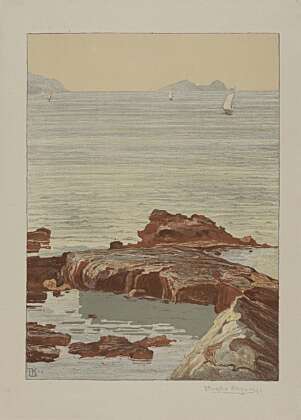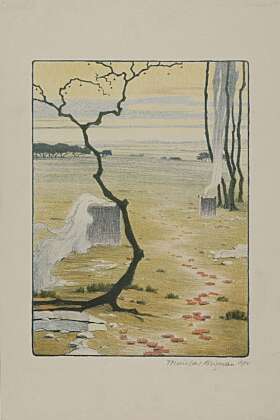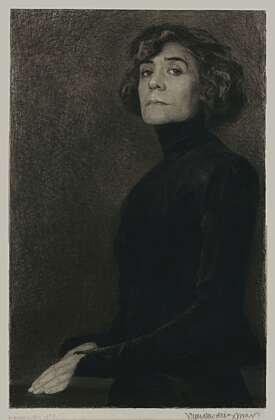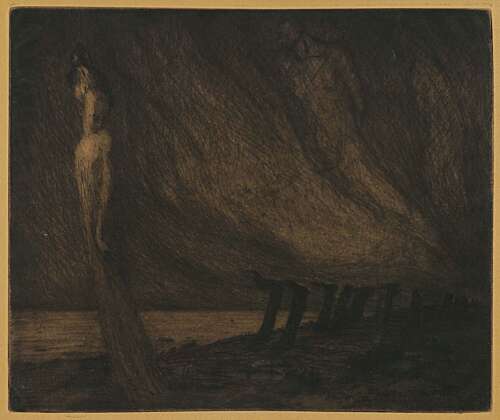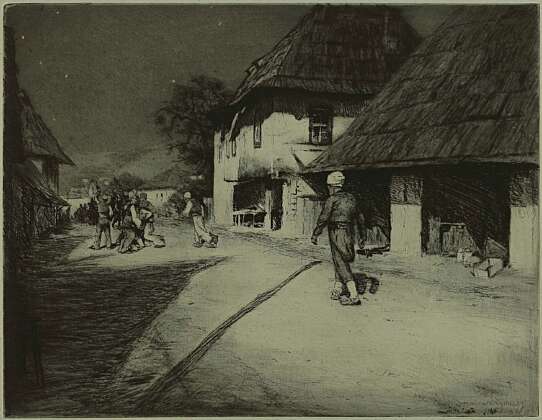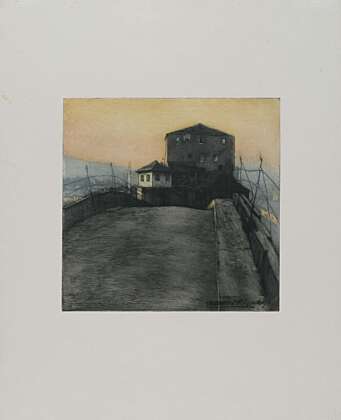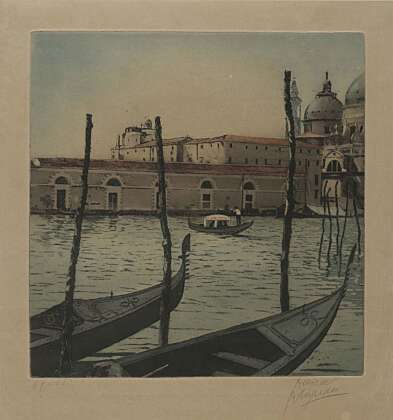Tomislav Krizman’s Printmaking Mission
Krizman polished the basics of painting and print, acquired from Auer, Csikos-Sesija and Crnčić during his training in Zagreb, in Vienna under baron Myerbach at the School of Artistic Craft (1902-1905), after which he enrolled in the specialist study of printmaking at the Academy of Art under William Unger (1905-1907). His ten-year sojourn in Vienna (1902-1911) was the most fruitful period of Krizman’s artistic development, which made an impact on his original stylistic tendency, i.e. Art Nouveau orientation. Among Viennese avant-garde art and literature elite, as a regular visitor of current exhibitions and a participant at exhibitions in Hagebund, Jungbund, Künstlerhaus and Secession, Krizman, unhindered by institutional and teaching authorities, having adopted the painting and printmaking doctrines of Myerbach and Ungar, embarked on the Art Nouveau tidal surge which unrelentingly pervaded Central European cultural ambience. Krizman embraced Art Nouveau premises, united under the motto “symbol, decoration, expressive power”, as it clearly corresponded to his artistic disposition. Krizman’s finest print works were made in his Vienna studio and are today already so deeply ingrained in collective memory as anthological examples of universal morphological and stylistic solutions. Influences of his teachers are clearly discernible in the prints made during this period, most of all in the implementation of Ungar’s academic rules of etching and Crnčić’s atmospheric ‘documentary prints’, although Krizman imparted a more personal, powerful, elongated and restless trademark stroke on his prints. In the stimulating Viennese ambience Krizman became acquainted with the proclamatory pieces of the Art Nouveau movement; the Klinger-Klimt-Hodler creative solutions and Kokoschka’s expressionist soars must have remained deeply etched in his memory. Even critics admitted he had managed to absorb the influences he was exposed to, but at the same time also to secede them from his own prints and hence establish a personal creative morphology.
Introduction
In the year marking the 140 th birthday of Tomislav Krizman (1882-1995), the Department of Prints and Drawings of the Croatian Academy of Sciences and Arts has set to present the artist’s prints kept in the institution for decades. A virtual exhibition of Tomislav Krizman’s anthological pieces is an homage to the artist’s committed efforts to elevate graphic art to the level of an independent discipline inside the body of Croatian modern art. His first retrospective exhibition was curated by Slavko Batušić in 1954 in Zagreb and Ljubljana. A monographic exhibition curated by Smiljka Domac-Ceraj followed, held in 1995 in the Art Pavilion in honour of the 40 th anniversary of Tomislav Krizman’s death, which systematically presented a selection from Krizman’s entire oeuvre (prints, paintings, set design, applied art and design). The printing heritage from the holdings of the Department of Prints and Drawings was presented at an exhibition in 2007 celebrating Krizman’s 125 th birthday, accompanied by an exhibition catalogue.[1] Following in the footsteps of Crnčić and guided by his own motto – “a printmaker should think and feel in copper, stone and wood” (T. Krizman, 1952: 8), he established high standards in Croatian printmaking art and contributed to a better valorisation and popularisation of the print medium.
Somewhere in between Crnčić’s impeccable graphic expression and Babić’s unstoppable modern notions,[2] Tomislav Krizman played a key role in the generation shift period,[3] bridging the style gap between academic and modernist stylistic-morphological sphere.
Schooling and artistic training in Art Nouveau Vienna
Krizman polished the basics of painting and print, acquired from Auer, Csikos-Sesija and Crnčić during his training in Zagreb, in Vienna under baron Myerbach at the School of Artistic Craft (1902-1905), after which he enrolled in the specialist study of printmaking at the Academy of Art under William Unger (1905-1907). His ten-year sojourn in Vienna (1902-1911) was the most fruitful period of Krizman’s artistic development, which made an impact on his original stylistic tendency, i.e. Art Nouveau orientation. Among Viennese avant-garde art and literature elite, as a regular visitor of current exhibitions and a participant at exhibitions in Hagebund, Jungbund, Künstlerhaus and Secession, Krizman, unhindered by institutional and teaching authorities, having adopted the painting and printmaking doctrines of Myerbach and Ungar, embarked on the Art Nouveau tidal surge which unrelentingly pervaded Central European cultural ambience. Krizman embraced Art Nouveau premises, united under the motto “symbol, decoration, expressive power”, as it clearly corresponded to his artistic disposition. Krizman’s finest print works were made in his Vienna studio and are today already so deeply ingrained in collective memory as anthological examples of universal morphological and stylistic solutions. Influences of his teachers are clearly discernible in the prints made during this period, most of all in the implementation of Ungar’s academic rules of etching and Crnčić’s atmospheric ‘documentary prints’, although Krizman imparted a more personal, powerful, elongated and restless trademark stroke on his prints.[4] In the stimulating Viennese ambience Krizman became acquainted with the proclamatory pieces of the Art Nouveau movement;[5] the Klinger-Klimt-Hodler creative solutions and Kokoschka’s expressionist soars must have remained deeply etched in his memory. Even critics admitted he had managed to absorb the influences he was exposed to, but at the same time also to secede them from his own prints and hence establish a personal creative morphology.
The artist’s oldest works from the Viennese period in our holdings, the lithographs Allegory of Autumn, Cain and Abel and A Leitmotif from Dubrovnik from the early 20 th century, stand out with a ‘typical Art Nouveau stylisation’,[6] recognisable echoes of Japanese art, a more modern idiom and a high level of stylistic aestheticism. Colour woodcuts (of smaller dimensions, printed on soft Japanese paper) make up an intimate group of curiosities and the starting point of Krizman’s first steps in printmaking: from the atmospherically toned subdued hues of Coastal Houses in the Night and a more open palette of Elevated Houses in Bosnia, to the sentimental Medulić-style composition of A Stroke of Fate, to the Art Nouveau portrait of Marya Delvard with a stage scene in the background (Marya Delvard in Profile / Stage Composition).
Having mastered the skill of etching, Krizman committed himself increasingly to this technique; “painstakingly and lovingly he etched copper, patiently and persistently executing strokes with a roulette and a roller, gently shading with a dry needle or applying light paint tones on coloured prints” (M. Grbić, 1982: 46). His etchings of ‘Art Nouveau stylisation’ in the wake of ‘atmospheric symbolism’[7] are characterised by clarity of arrangement, solidity and homogeneity of graphic composition, rhythmic exchange of darker and lighter parts, strong elongated and restless stroke and character outlining: Mother and Child, In the alley, Illustration d’une chanson and the powerfully realistic Procession with a self-portrait with a hat inserted among the characters. In his etching portfolio Skizzen und Eindrücke aus Dalmatien, Bosnien, Kroatisch Zagorien und Wien (1907) he has left etched documents of the impressions he had gained on his many travels, with visible traits of Crnčić and Unger in a perfect technique of academically arranged compositions and a choice of motifs of a specific dreamy and nostalgic mood, gentle colour transitions and a calmer stroke (Fishermen in the Bay of Hvar, Snow Cleaners on Donaukanal in Vienna, Evening in the Bay of Hvar, Moonlight over Kvarner, Cypresses at a Cemetery near Dubrovnik …). The coloured etchings Self-portrait and Marya Delvard from 1908 are magnificent examples of Croatian Art Nouveau prints: vertically elongated compositions of impressive dimensions, restrained decorativeness, virtuoso technicality. A success with both critics and audience, thanks to these two etchings, launched a series of commission of bourgeois portraits in which Krizman justified the expected level of metier (Pianist Schlemmer-Ambrozić, a typical bourgeois portrait with accompanying props) and demonstrated painstaking psychological power of perception (Portrait of Petar Konjović), which he further accentuated in Self-portrait and Portrait of Ivan Meštrović.
Lithographic poster Marya Delvard – a masterpiece of Art Nouveau design
Krizman’s lithographic posters consistently follow the Art Nouveau principles of graphic design, respecting the given two-dimensionality of the surface onto which the author applies the drawing of accentuated outlines and asymmetrical placement, surrounding it with condensed capital letters, creating an ideal combination of style and expression, of image and text[8] (Marya Delvard, Tkalčić-Gruss Concert, Large Party at the Lady’s Club, ‘Old Border Guard’ Liqueur).
The Art Nouveau poster Marya Delvard, of whose mysterious origin, cause and date of making was written in most detail by Renata Gotthardi-Škiljan[9] and which is so far one of the rare preserved copies in Europe, is an outstanding achievement not only of Croatian, but also of European poster design. A lot has already been written about the Viennese diseuse, Krizman’s muse and ‘demon’ (Matoš). Her preternatural appearance, confident cabaret posture, exulted coolness of her pale visage and her elongated body in a black dress with a white sash around her neck have become anthological.
Marya Delvard was a famed reciter who performed in the early 20 th century in the then popular and avant-garde literary cabarets of Vienna and Munich and whose mysterious appearance and specific artistic performance – “sepulchrally trembling and unkindly broken“[10] voice inspired countless artists and literati of the period. From documents and writings[11] we learn that Krizman saw her in the Viennese Fledermaus cabaret and possibly also in Munich, in her home cabaret Die Elf Scharfrichter. The unearthly appearance of this femme fatale, who remained remembered in Croatian fine art as Krizman’s Delvard woman thanks to this poster, is quite impressive. Krizman’s fascination with the life and work of Marya Delvard – of which A. G. Matoš writes (1909: 274-277): “… He has already become a nuisance with this Delvard woman of his. If this apocalyptic persona is his demon, she doesn’t have to be ours…” – is visible in this artist’s other pieces as well: in two already mentioned etching portraits from 1908[12] and in the rare woodcut printed on superthin Japanese paper (Marya Delvard In Profile / Stage Composition). These works are not only outstanding portrait studies, but also documents of time and the dominant mood of Art Nouveau Vienna where Krizman sojourned during those years.
Composition-wise, the poster consistently adheres to the Art Nouveau principles of graphic design, respecting the given two-dimensionality of the surface, onto which Krizman applied an accentuated and asymmetrically placed drawing, pairing it with distinct letter case. By striking a balance between the image and the grapheme, the poster transcended its role of a single-use message transmitter and became an Art Nouveau emblem, a synonym of the universal combination of visual and typographic elements and a timeless reminder of Krizman’s artistic vein.
Diversity of motif and style in the printmaking oeuvre
Around the time of the establishment of the Medulić collective, Krizman abandoned the linear Art Nouveau stylisation and started creating in the wake of Medulićesque symbolism and return to folk myth, the history of his nation and general striving to revival. Therefore, in line with the tendency, elements and colours of folklore can be traced in several of his works (Dalmatian Shepherdess, Return / Shepherdess), although he applied ethnic ornamentation more on his applied art and design works. After a health condition caused by paints (J. Draganić, 1934: 10), Krizman abandoned painting and turned even more passionately to the printmaking medium, demonstrating enviable metier prowess and stylistic diversity. He gathered his broad range of topics on his sporadic journeys to Zagreb, Dalmatia, Bosnia, Belgrade, Munich, Paris, Italy (Mostar Bridge, Willows on the Sava, Venice / Entering Canal, Nocturnal Street / Bosnia, Friar Grga Martić on his Catafalque, Finale, Snow-covered Hillside Street.)
After the Balkan wars (1912-1913) Krizman travelled to Serbia, Macedonia and Kosovo and photographed[13] and “registered his experiences of landscapes, monuments of medieval Serbian and Macedonian architecture, urban and rural parts with bazaars, bedestens, mahallahs and charshias as a thus far unknown, idiosyncratic world. (…) He processed the registered motifs in different graphic techniques – woodcut, etching, engravings, monotype and lithography – where his sense of decisive line cutting yielded solidly composed and condensed units. He loved dark outlines and dense surfaces in the foreground, which turned lighter and lighter in each new ground to the point of sophisticated fading in faraway depths. His technical mastery in processing metal plates was unsurpassed.” (S. Batušić, 1954: 8) He later re-evoked and re-processed these absorbed impressions, albeit in a somewhat freer expression, in his large (1917) and small (1918) portfolio Macedonia.
The Spring Salon expressionism in the 1920s only glanced him off. A certain penetration into expressionist trends was visible in the lithographs Madonna with Child from the Spring Salon portfolio (1920) and Kiss, as well as etchings Christ on the Lake and Funeral in Rab, which already took a step away from his much-loved routine subjects, although technically perfect: urban and rural vistas (Slunj).
A substantial downward trajectory and an “unstoppable step into routine“[14] are visible in the post-war prints inspired by Tito[15] which bear no traces of the genius temperament from the first decade of the past century. Grgo Gamulin wrote about the stylistic decline (1995: 207): “In oil painting he never achieved a notable level, but it is quite uncomfortable that his art of etching (…), undoubtedly remarkable in the Art Nouveau period, as early as in the beginning of the third decade took down the slippery slope of illustration (Sight of Yugoslavia). In fact, immersed in his magnum opus, not only in etching, but also in ink lavee, lithographs, woodcuts and drawings, Krizman could no longer find the way from observation to style and transcend the simple description of motifs.”
Proponent of the graphic medium
Upon returning from Vienna, in 1912 Krizman started teaching at the School of Crafts and between 1922 and 1955 he taught at the Department of Prints and Drawings of the Zagreb Academy of Fine Arts, where he trained generations and generations of graphic artists. The most famous is the so-called Krizman’s circle: Anka Krizmanić, Dušan Kokotović and Vjera Bojničić. As a set designer in Croatian National Theatre, over the years he designed countless sets for famous operas. As the founder of an association for artistic crafts promotion Djelo, he took part in organising applied arts exhibitions, along with many other efforts he invested in promoting all aspects of Croatian fine art. Nevertheless, he is the most deserving for the continuation of Crnčić’s ongoing process of promotion of Croatian prints and drawings, making the etching and lithography[16] medium equal to other art disciplines, popularising it among the broadest local and foreign audience.
With a virtual exhibition we aim to re-emphasise the immense role of academician Tomislav Krizman in Croatian art and once again to remind of his remarkable printmaking heritage. Krizman, a ‘successor and disciple’ of Crnčić, completed the already active process of laying the groundwork for Croatian graphic expression in the turbulent times in European culture. With a selection and presentation of the anthological works from this artist’s legacy kept in the holdings of the Department of Prints and Drawings, Krizman’s predilection – prints – as the medium that let his artistic talent, modernist expression and unparalleled creative zeal shine the brightest is once again brought to the forefront.
Ružica Pepelko
***
[1] Pepelko, Ružica (2007), “Grafička ostavština Tomislava Krizmana”, in: exhibition catalogue Tomislav Krizman / iz fundusa Kabineta grafike HAZU, Department of Prints and Drawings of the Croatian Academy of Sciences and Arts, Zagreb, pp. 4-7, 69-79.
[2] In poster and illustration art Gamulin categorises him between Rački and Babić (see Gamulin, Grgo (1995), “Tomislav Krizman”, Hrvatsko slikarstvo na prijelazu iz XIX. u XX. stoljeće, vol. 2, Naprijed, Zagreb, pp. 207, 213).
[3] The years of Art Nouveau influx from Vienna, the period from 2897, when Vereinigung bildender Künstler Österreichs separated from Künstlergenossenschaft, coinciding with the ‘emancipation’ of Zagreb’s Croatian Artists Association from the Croatian Art Society (see Maleković, Vladimir (1999), Stilovi i tendencije u hrvatskoj umjetnosti XX. stoljeća, Art studio Azinović, Zagreb, p. 9).
[4] In the text Jugoslovenska grafika 1900–1950 (Struktura razvojnog procesa) M. Protić points out how Tomislav Krizman’s work is a meeting point of parallel modern and academic solutions. He also highlights the direct influence of Vienna and the indirect of Beardsley and Mackintosh (exhibition catalogue Jugoslovenska grafika 1900–1950, Museum of Contemporary Art, Belgrade, 1977/78, pp. 12-13).
[5] By recommendation of Agramer Zeitung’s art critic Otto Kraus, he entered the society of the pioneers of modernism: Altenberg, Friedel, Loos, Moser, Klimt, Roller, Lehar, claims Draganić, Josip (1934), “Tomislav Krizman. Uz umjetnikovu pedesetogodišnjicu”, Novosti, Zagreb, year 28, no. 21, 21 January, p. 10
[6] Domac Ceraj, Smiljka (1995), Tomislav Krizman. Retrospektivna izložba, Zagreb, Art Pavilion, p. 20.
[7] Gagro, Božidar (1977), “Hrvatska grafika u prvoj polovini 20. Stoljeća”, exhibition catalogue Jugoslovenska grafika 1900-1950, Museum of Contemporary Art, Belgrade, p. 28.
[8] Kavurić, Lada (2003), “Oblikovanje plakata i knjige”, exhibition catalogue Secesija u Hrvatskoj, Museum of Arts and Crafts, Zagreb, 2003/2004, pp. 127–128.
[9] More details about the poster: Gotthardi-Škiljan, Renata (1975), “Plakat u Hrvatskoj do 1941.”, Department of Prints and Drawings of the Yugoslav Academy of Sciences and Arts, Zagreb, pp. 64–66. and Kedmenec Križić, Vesna (2011), Prvaci hrvatskog plakata / Csikos, Crnčić, Krizman, Babić, Department of Prints and Drawings of the Croatian Academy of Sciences and Arts, Zagreb, pp. 26-27.
[10] Babić, Ljubo (1955), Između dva svijeta, Zagreb, p. 23
[11] Krizman’s correspondence with Dušan Plavšić (the Plavšić Legacy, Croatian State Archives) and Plavšić’s oral testimonies (R. Gotthardi-Škiljan, 1975: 64-66).
[12] The motif of Delvard’s chin and lips was incorporated even in the upper right-hand corner of the large-scale etching Self-portrait from 1908!
[13] The photo archives of the Department of Prints and Drawings of the Croatian Academy of Sciences and Arts keeps fifty-eight photographs taken by Krizman on his many travels, which depict a literal transferral of a photographed motif onto a print.
[14] Gamulin, Grgo (1995), “Tomislav Krizman”, Hrvatsko slikarstvo na prijelazu iz XIX. u XX. stoljeće, vol. 2, Naprijed, Zagreb, p. 207.
[15] The 1950s etchings: Interior of Marshal Tito’s Childhood Home in Kumrovec (inv. no. KG HAZU 3116), Marshal Tito’s Childhood Home (inv. no. KG HAZU 5118) and Comrade Tito’s Portrait (inv. no. KG HAZU 10816).
[16] Hozo points out that the history of contemporary artistic lithograph in the early 20 th century in Croatia began with Tomislav Krizman (see Hozo, Dževad (1988), Umjetnost multioriginala, Prva književna komuna, Mostar, p. 229). Krizman was among the first in Zagreb to promote lithography of the so-called ‘artistic stonecutting’, says Maković, Zvonko (2009), “Osnivači zbirke: Ljubo Babić, Menci Clement Crnčić, Tomislav Krizman”, in: exhibition catalogue Od Klovića i Rembrandta do Warhola i Picelja, National and University Library, Zagreb, p. 30.

Allegory of Autumn / Autumn
colour lithograph, 1904
275 x 295 / 370 x 488 mm; litho paper
sign. bottom below image in pencil: Tomislav Krizman 1904.;
sign. inside image bottom right corner (print): TK
inv. no. KG HAZU 2322

Cain and Abel / Altars
colour lithograph, 1904.
349 x 256 / 514 x 335 mm; litho paper
sign. below image in pencil: Tomislav Krizman 1904.
inv. no. KG HAZU 2324

A Leitmotif from Dubrovnik / Cliffs above the Sea
colour lithograph, 1903
377 x 273 / 475 x 337 mm; litho paper
sign. bottom right below image in pencil: Tomislav Krizman;
inside image monogram bottom left corner (print): TK 03.
inv. no. KG HAZU 2325

Elevated Houses in Bosnia
colour woodcut, 1904
220 x 290 / 249 x 342 mm; Japanese paper
sign. inside image bottom right corner in pencil: Tom.Krizman;
below image left in pencil: 1904; bottom left corner inside image (print): TK
inv. br. KG HAZU 2317

Stroke of Fate / Widows
woodcut, (1908)
333 x 402 mm; yellowish paper
sign. bottom right inside image in pencil: Tomislav Krizman;
bottom right corner monogram (print): TK
inv. no. KG HAZU 2333

Marya Delvard in Profile / Stage Composition
woodcut, (1908)
417 x 310 mm; thin Japanese paper
sign. bottom below image in pencil: Tomislav K;
sign. bottom left corner in plate: T
inv. no. KG HAZU 9403
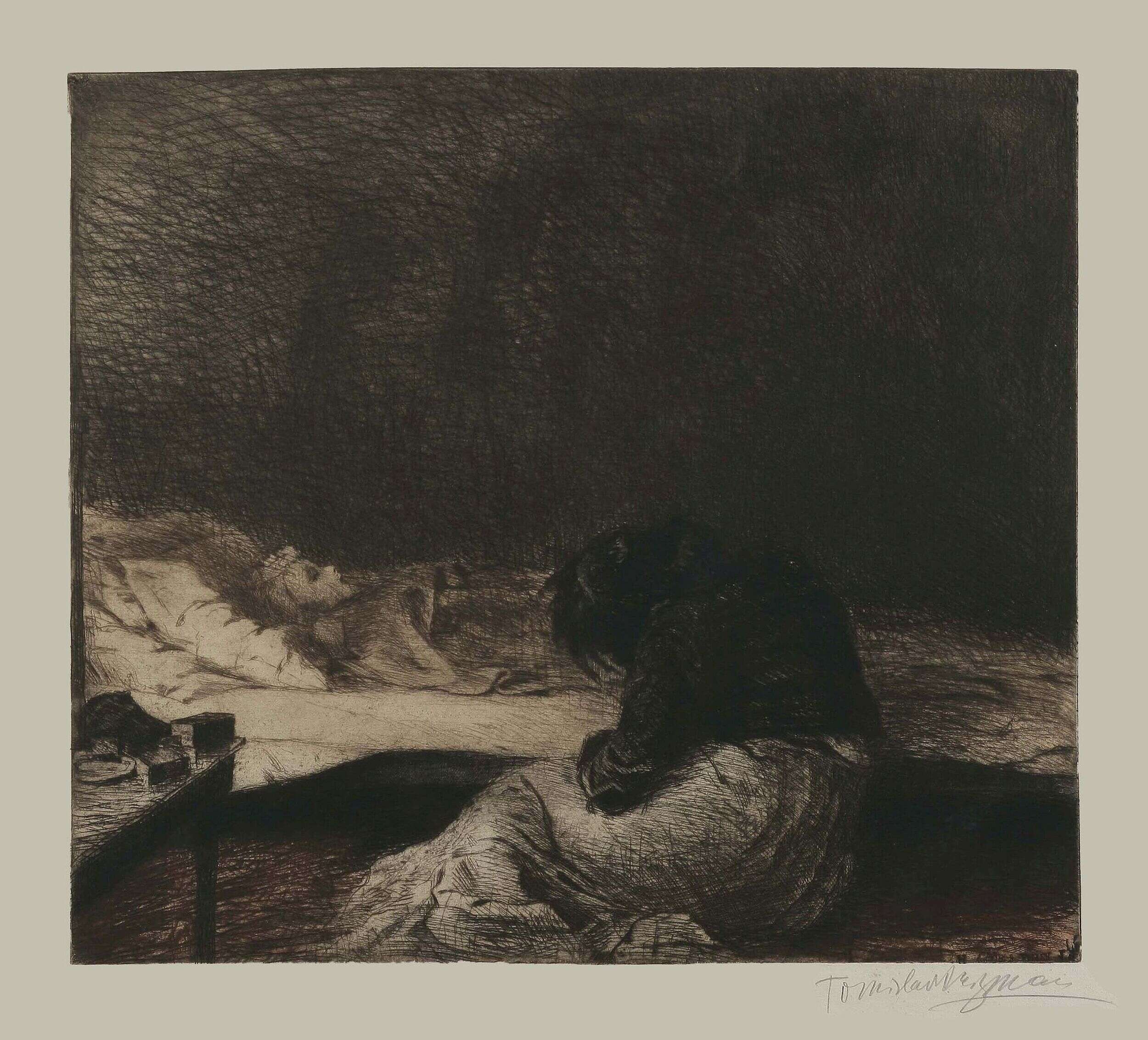
Mother and Child / Child on a Catafalque
etching, (1908)
486 x 546 / 674 x 806 mm; Bütten paper
sign. bottom below print in pencil: Tomislav Krizman
inv. no. KG HAZU 2344

In the Alley
etching (1904)
273 x 355 / 345 x 470 mm; thin paper
sign. bottom below print in pencil: Tomislav Krizman
inv. no. KG HAZU 2330

Illustration d'une chanson
etching, (1908)
231 x 278 / 249 x 324 mm; thin orange paper
no sign.
inv. no. KG HAZU 2328

Procession
etching, (published 1909), dated 1911
945 x 1040 mm (sheet edges cut); print paper
sign. bottom right corner inside print in red chalk:
Ex 5/5 // 911 Tomislav Krizman
inv. no. KG HAZU 2370

Fisher in der Bucht von Lesina (Fishermen in the Bay of Hvar)
From the portfolio Skizzen und Eindrücke aus Dalmatien, Bosnien, Kroatisch Zagorien und Wien (Vienna, 1907)
/ From the portfolio Sketches and Impressions from Dalmatia, Bosnia, Hrvatsko zagorje and Vienna (Vienna, 1907)
colour etching
115 x 292 / 390 x 488 mm; paperboard
sign. bottom below print in pencil: Tomislav Krizman;
imprinted monogram below print in the middle: TK // ALBUM
inv. no. KG HAZU 2300

Schneeschaufler am Donaukanal in Wien (Snow Cleaners on the Donaukanal in Vienna)
From the portfolio Skizzen und Eindrücke aus Dalmatien, Bosnien, Kroatisch Zagorien und Wien (Vienna, 1907)
/ From the portfolio Sketches and Impressions from Dalmatia, Bosnia, Hrvatsko zagorje and Vienna (Vienna, 1907)
etching, aquatint
131 x 331 / 393 x 495 mm; paperboard
sign. bottom below print in pencil: Tomislav Krizman;
imprinted monogram below print in the middle: TK // ALBUM
inv. no. KG HAZU 2302

Abend in der Bucht von Lesina (Evening in the Bay of Hvar)
From the portfolio Skizzen und Eindrücke aus Dalmatien, Bosnien, Kroatisch Zagorien und Wien (Vienna, 1907)
/ From the portfolio Sketches and Impressions from Dalmatia, Bosnia, Hrvatsko zagorje and Vienna (Vienna, 1907)
etching
228 x 365 / 238 x 365 / 392 x 490 mm; paperboard
sign. bottom below print in pencil: Tomislav Krizman;
imprinted monogram below print in the middle: TK // ALBUM
inv. no. KG HAZU 2307
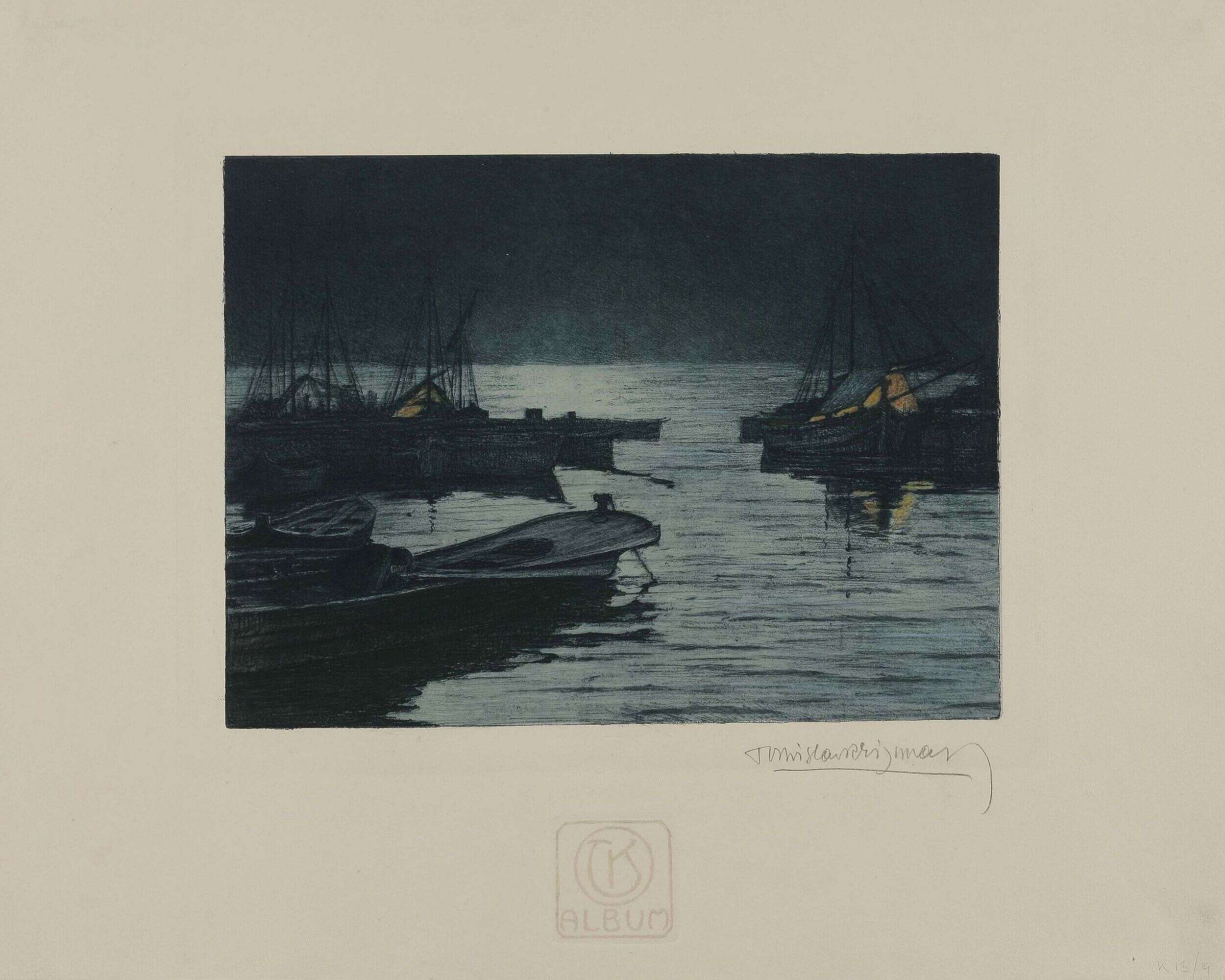
Monduntergang am Quarnero (Moonlight over Kvarner)
From the portfolio Skizzen und Eindrücke aus Dalmatien, Bosnien, Kroatisch Zagorien und Wien (Vienna, 1907)
/ From the portfolio Sketches and Impressions from Dalmatia, Bosnia, Hrvatsko zagorje and Vienna (Vienna, 1907)
etching, aquatint
224 x 303 / 260 x 338 / 393 x 493 mm; thicker print paper
sign. bottom below print in pencil: Tomislav Krizman;
imprinted monogram below print in the middle: TK // ALBUM
inv. no. KG HAZU 2308

Cypressen am Friedhof bei Gravosa (Cypresses at a Cemetery near Dubrovnik)
From the portfolio Skizzen und Eindrücke aus Dalmatien, Bosnien, Kroatisch Zagorien und Wien (Vienna, 1907)
/ From the portfolio Sketches and Impressions from Dalmatia, Bosnia, Hrvatsko zagorje and Vienna (Vienna, 1907)
etching
370 x 316 / 495 x 393 mm; yellowish print paper
sign. bottom below print in pencil: Tomislav Krizman;
imprinted monogram below print in the middle: TK // ALBUM
inv. no. KG HAZU 2309

Self-portrait
etching, (1908)
823 x 450 / 821 x 448 / 896 x 619 mm;
sign. lower left corner inside print: TK;
right corner below image in pencil: Tomislav Krizman
inv. no. KG HAZU 2369

Marya Delvard
etching, (1908)
774 x 498 / 823 x 542 mm;
sign. right corner below print in pencil: Tomislav Krizman;
l.: Vorzugsexemplar No 2.
inv. no. KG HAZU 2368
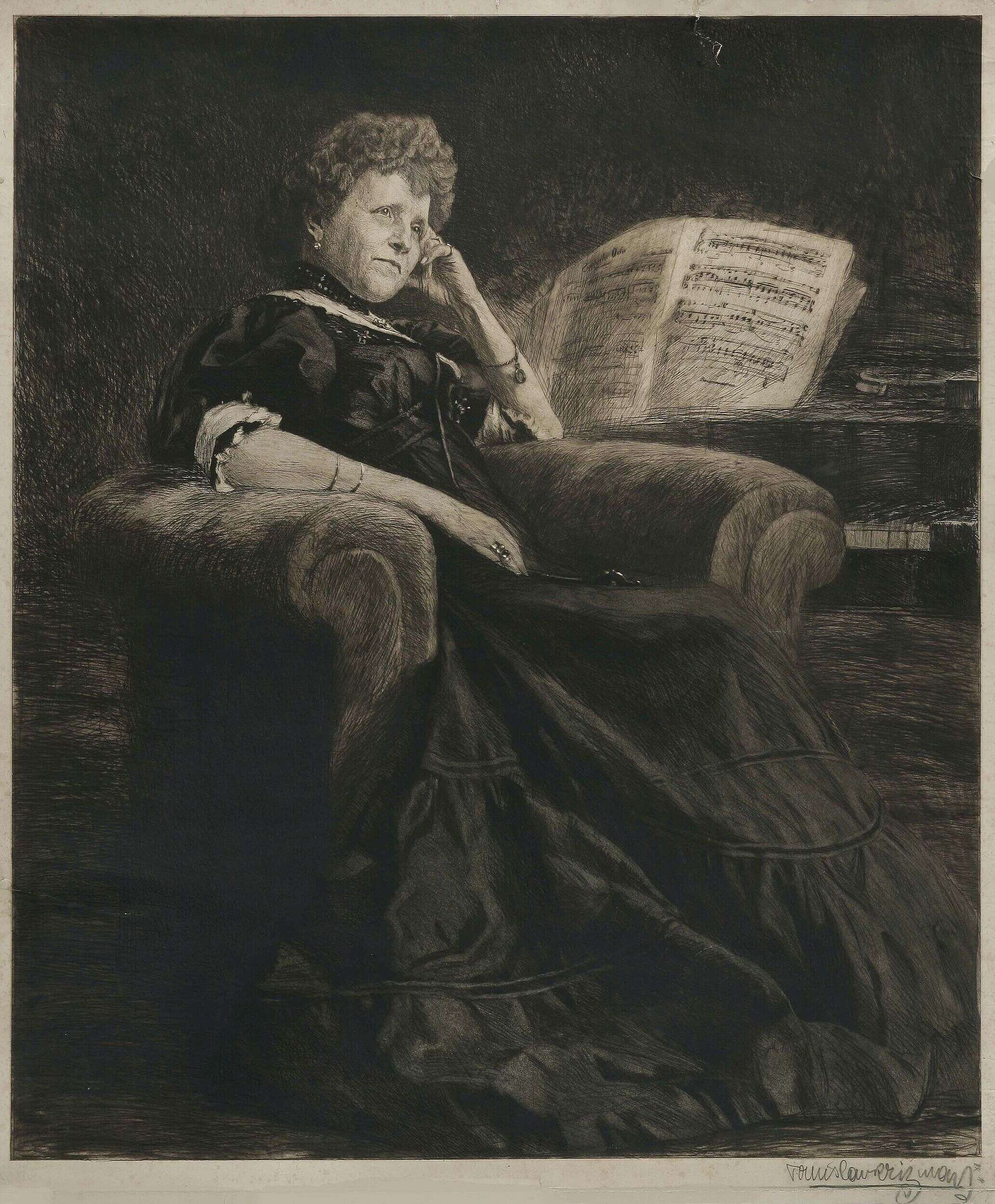
Pianist Schlemmer-Ambrozić
etching, (1908)
992 x 840 / 1048 x 875 mm; thinner paper (mâché)
sign. bottom right below print in pencil: Tomislav Krizman
inv. no. KG HAZU 2376

Self-portrait
etching, (1931)
406 x 302 / 438 x 325 mm; yellowish paperboard
sign. bottom below print in pencil: Tomislav Krizman
inv. no. KG HAZU 3749

Portrait of Ivan Meštrović
etching, 1933
676 x 490 / 890 x 650 mm; Bütten paper
sign. bottom below print in pencil: Tomislav Krizman 933;
l.: Ex 5 of 5
inv. no. KG HAZU 4992

Marya Delvard
poster / colour lithograph, (around 1907)
1264 x 953 mm
sign. bottom right corner inside image: TOMISLAV KRIZMAN
print: Christoph Reisser Söhne, Wien
inv. no. KG HAZU 685-III

Tkalčić-Gruss Concert
poster / colour lithograph, 1915
1256 x 948 mm
sign. bottom left corner inside image: TOMISLAV // K
print: Litografski odio Kraljevske zemaljske tiskare, Zagreb
inv. no. KG HAZU 143-III

Large Party at the Lady's Club
poster / colour lithograph, (around 1910)
1250 x 918 mm;
sign. bottom middle inside image: TOMISLAV KRIZMAN
print: Svjetlotiskarski zavod R. Mosinger d. d. Zagreb
inv. no. KG HAZU 146-III

Dalmatian Shepherdess
etching, 1909
243 x 301 / 322 x 402 mm; yellowish paper
sign. bottom below print in pencil: Tomislav Krizman 1909;
l.: 9 de 10 Epreuves
inv. no. KG HAZU 2331

Return / Shepherdess
etching, 1910
496 x 560 / 560 x 613 mm; Bütten paper
sign. bottom below print in pencil: Tomislav Krizman 910
inv. no. KG HAZU 4582
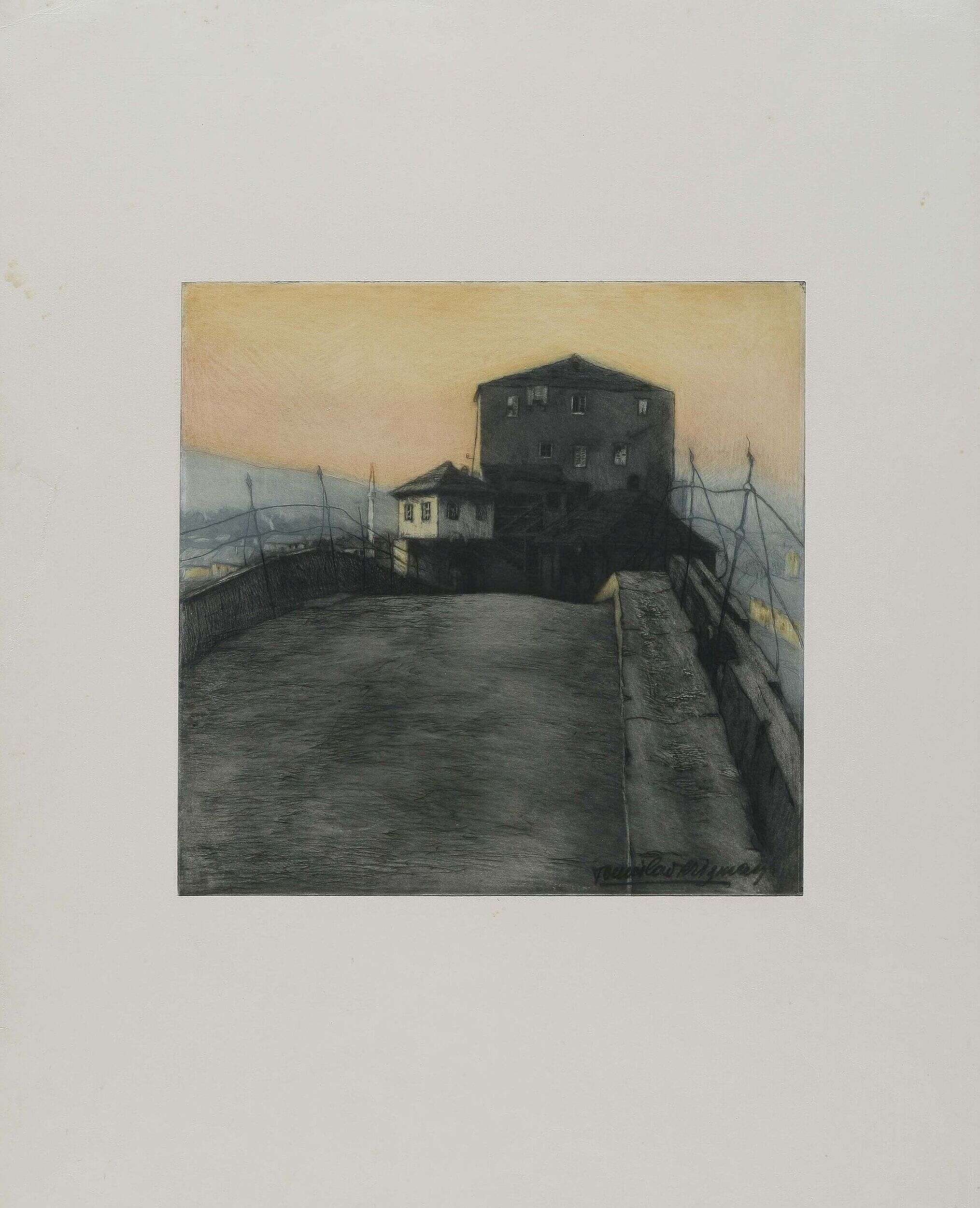
Mostar Bridge
etching, aquatint, (1911)
296 x 301 / 624 x 476 mm; paperboard
sign. bottom right corner in plate: Tomislav Krizman
inv. no. KG HAZU 3191

Above the Puddle / Wilows on the Sava
etching, aquatint, 1912
178 x 282 / 324 x 493 mm; paperboard
sign. bottom below print in pencil: Tomislav Krizman 912 ex (… illegible)
inv. no. KG HAZU 3178

Venice, Entering Canal Grande
colour etching, aquatint, (1913)
379 x 403 / 476 x 440 mm; natron paper
sign. bottom below print in pencil: Tomislav // Krizman;
l.: 17 of 25
inv. no. KG HAZU 4603

Strasse bei Nacht, Bosnien (Nocturnal Street, Bosnia)
etching, (around 1907)
383 x 497 / 459 x 574 mm; thin green-toned paper
sign. bottom right corner inside print in pencil: Tomislav Krizman // 3 de 10
inv. no. KG HAZU 2343

Friar Grga Martić on his Catafalque
etching, 1914
166 x 200 / 261 x 299 mm; yellowish paperboard
sign. bottom below print in pencil: Tomislav Krizman 914;
l: „fra Grga Martić” // ex 5 of 10
inv. no. KG HAZU 2360

Finale
etching, 1917
377 x 422 / 460 x 500 / 557 x 586 mm; Bütten paper
sign. bottom below print in pencil: Tomislav Krizman 917.;
l.: Ex 7. of 10. „finale”
inv. no. KG HAZU 2365

Snow-covered Hillside Street
etching, (around 1917)
etching
508 x 299 / 665 x 434 mm; yellowish paperboard
sign. bottom below print in pencil: Tomislav // Krizman
inv. no. KG HAZU 3186

Madonna with Child
From the Spring Salon portfolio, 1920
lithograph
479 x 349 mm; litho paper
sign. bottom right inside print in pencil: Tomislav Krizman 920
inv. no. KG HAZU 2355
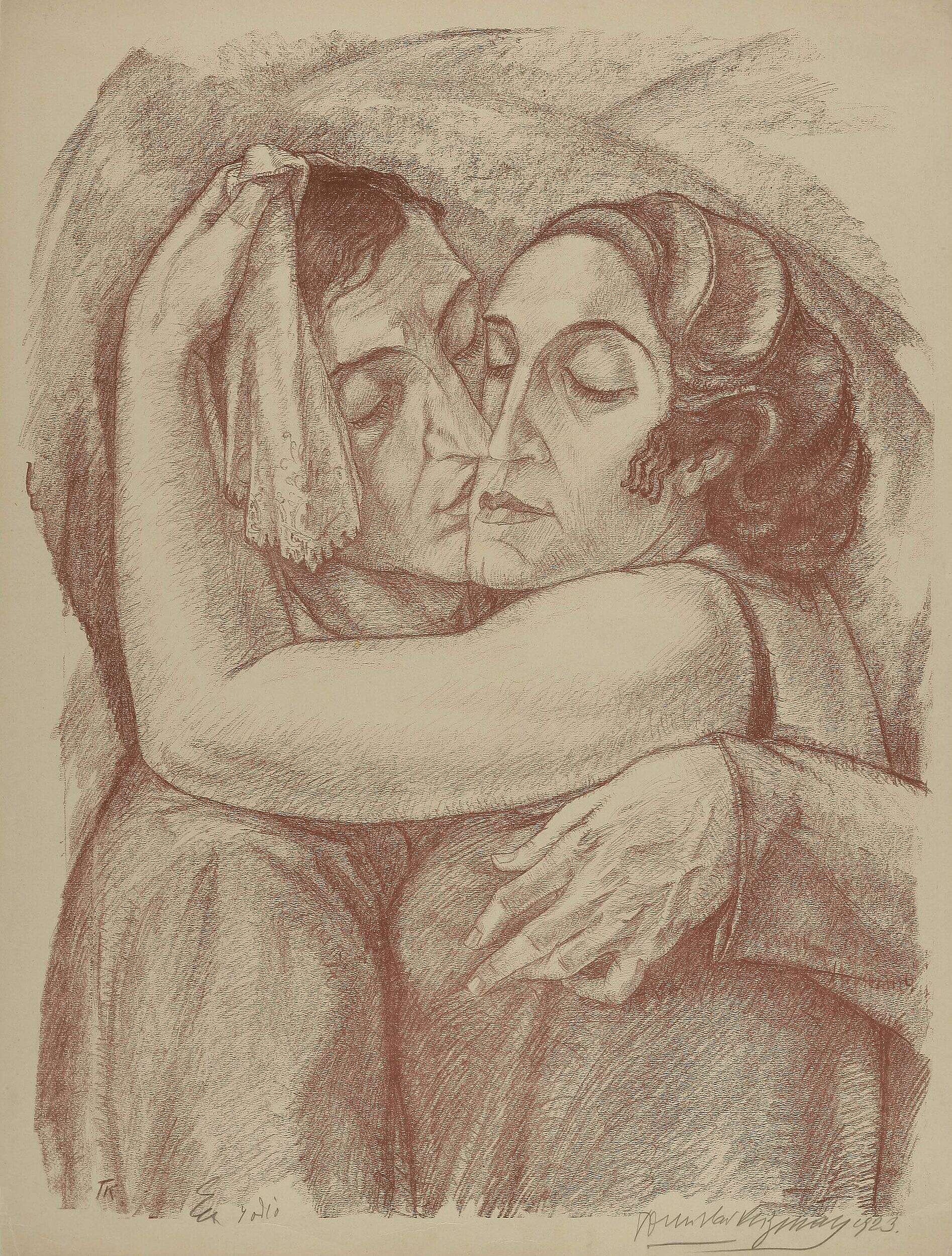
Kiss / Embrace / Lovers
lithograph, 1923
661 x 498 mm; yellowish smooth paperboard
sign. right corner below image in pencil: Tomislav Krizman 923.;
l.: Ex 4 of 10; sign. bottom left corner inside image (print): TK
inv. no. KG HAZU 2347

Christ on the Lake
etching, dry point, (1927)
302 x 478 / 535 x 760 mm; Bütten paper
no sign.; left below print in pencil: Ex 1 of 20
inv. no. KG HAZU 4585

Funeral in Rab
etching, 1928
550 x 473 / 678 x 538 mm; Bütten paper
sign. bottom below print in pencil: Tomislav Krizman 928.;
l.: Ex 13 of 20 Rab
inv. no. KG HAZU 2353

Slunj
etching, aquatint, (1920)
466 x 493 / 577 x 617 mm; paperboard
sign. upper left corner inside print in pencil: Tomislav Krizman
inv. no. KG HAZU 4528

